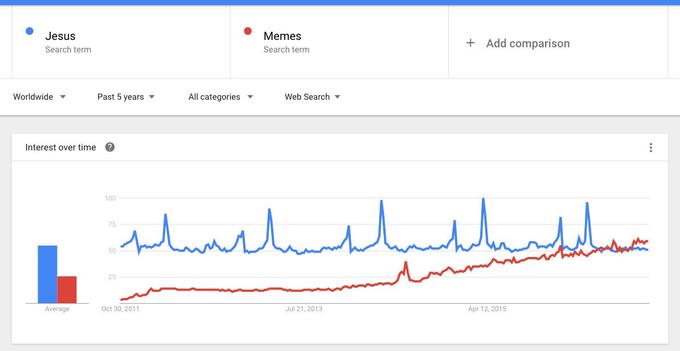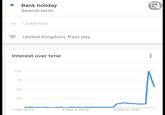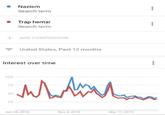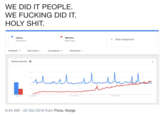Google Trends
Part of a series on Google. [View Related Entries]
This submission is currently being researched & evaluated!
You can help confirm this entry by contributing facts, media, and other evidence of notability and mutation.
| Navigation |
| About • History • Features • Highlights • Search Interest • External References • Recent Images |
About
Google Trends is a public search data analytics service that shows how often a search term is entered in relation to the total volume of Google search queries across the world. In addition to visualizing the ebb and flow of a search term's popularity over time, Google Trends also enables its users to cross-compare the trend lines of up to five search terms, as well as the distribution of search queries by geographical regions and languages.
History
On May 11th, 2006, Google introduced a web-based application that allows anyone to compare the relative difference in volume of queries between two or more search terms over time, starting from 2004 and onward. According to internet blog posts from early 2007, the service was sporadically maintained by Google until July that year.
On August 5th, 2008, Google released Insights for Search, an advanced search analytics service that visualizes the popularity of a search term by regional interest, as well as a leaderboard displaying most searched terms and rising search term.
On September 27th, 2012, Google Insights for Search was merged into Google Trends. On May 22nd, 2013, Google unveiled a revamped version of the service with more in-depth features, including Hot Searches, a daily trend chart listing each day's most searched keywords, and Top Charts, a hub page that provided at-a-glance view of top 10 most searched keywords in 40 different categories spanning across TV entertainment, cinema, music, sports, education, business and brands.
Features
- Google Trends helps researchers understand keyword trends. When they enter up to five search terms at a time, Google Trends will then respond with a graph showing how popular each term is. The site also features seasonal trends graphs,
regional trends and related trends. Google will also display the trends according to their prevalence. Researchers can enter a search term to see where it ranks in overall searches.
- Google also categorizes keywords according to how quickly they grow. Researchers can enter a search term and Google will present a graph showing how much growth, in percentages, it achieved during the time period selected. If the search term has recently exploded in popularity, Google will suggest that it is a “breakout” keyword.
- Google will automatically show a global search history when a user enters a search term into Google Trends. Hot searches keep users up to date with what people in a certain geographic area are searching for with a rough estimate of the number of searches the subject received.
- Since 2012, Google Trends has released an annual report of the top ranked keywords and keyphrases that people looked up on Google’s search engine. These lists can be viewed through global filters or by country. The lists include top searches in general as well as the top searches for people, athletes, news electronics and YouTube videos.
Search Data
Google Trends data is an unbiased sample of Google search data. Realtime data is a random sample of searches from the last 7 days while non-realtime data is a random sample of Google search data that can be pulled from as far back as 2004 and up to 36 hours before a search. After search data is collected, Google Trends categorize it, connect it to a topic, and remove any personal information. Trends excludes any searches made by very few people, repeated searches from the same person over a short period of time and queries with apostrophes and other special characters.[1]
Highlights
"Meme" vs. "Jesus"
On October 25th, 2016, Norwegian developer Dominik Salonen tweeted a screenshot of a Google Trends chart illustrating how the volume of search queries for "meme" eclipsed that of "jesus" for the first time in August that year. The finding was subsequently covered by several tech news outlets, including Gizmodo and Fortune.

Search Interest
External References
[2] Wikipedia – List of top trending Google Search queries by year
[3] Google Trends – Year in Search
[4] Something Awful – Interesting Google Trends
[5] Gizmodo – Memes Are Now Bigger Than Jesus on Google
[6] Fortune – The Internet Officially Cares More About Memes Than Jesus
[7] Twitter – @Kuwaddo's Tweet
Recent Videos
There are no videos currently available.
Recent Images 4 total
Share Pin
Related Entries 41 total
Recent Images 4 total
Recent Videos 0 total
There are no recent videos.






Comments ( 2 )
Sorry, but you must activate your account to post a comment.
Please check your email for your activation code.